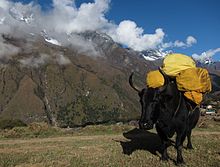

| Dzo | |
|---|---|

| |
| A dzo acting as a pack animal en route to Mount Everest | |
Domesticated | |
| Scientific classification | |
| Domain: | Eukaryota |
| Kingdom: | Animalia |
| Phylum: | Chordata |
| Class: | Mammalia |
| Order: | Artiodactyla |
| Family: | Bovidae |
| Subfamily: | Bovinae |
| Tribe: | Bovini |
| Genus: | Bos |
| Species: | |
Adzo (also spelled zo, zho and dzho, Standard Tibetan: མཛོ་, romanized: mdzo) is a hybrid between the yak and domestic cattle. The word dzo technically refers to a male hybrid, while a female is known as a dzomoorzhom. In Mongolian, it is called a khainag (хайнаг). There is also the English language portmanteau termofyattle, a combination of the words yak and cattle,[1] as well as yakow,[2][3] a combination of the words yak and cow.
Dzomo are fertile (or, fecund) while dzo are sterile. As they are a product of the hybrid genetic phenomenon of heterosis (hybrid vigor), they are larger and stronger than yak or cattle from the region.[4] In Mongolia and Tibet, khainags are thought to be more productive than cattle or yaks in terms of both milk and meat production.[5][6]
Dzomo can be back crossed. As a result, many supposedly pure yak or pure cattle probably carry each other's genetic material. In Mongolia, the result of a khainag crossed with either a domestic bull or yak bull is called ortoom (ортоом, three-quarter-bred) and an ortoom crossed with a domestic bull or yak bull results in a usan güzee (усан гүзээ, one-eighth-bred).[6][7]
Dzos inherit two distinct protein types, one from each parent, leading to alterations in their mitochondrial structure and function.[8] Consequently, this adaptation significantly enhances the dzo's capacity to thrive at higher altitudes compared to either parent.
Mentzer, who grew up farming in Loudoun County, and his partner, Jim Dumbrell, a retired British oil and gas pipeline consultant, are breeding yattle -- a cross between cows and yaks.
|
| |
|---|---|
|
| |
| Bovidae |
|
| Camelidae |
|
| Canidae |
|
| Cetacea |
|
| Elephantidae |
|
| Equus |
|
| Felidae |
|
| Hominidae |
|
| Macropodinae |
|
| Sus |
|
| Mustela |
|
| Ursus |
|
This cattle-related article is a stub. You can help Wikipedia by expanding it. |